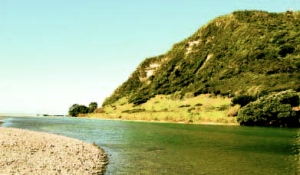Tēnei anō te ika kei te ngutuawa o Awatere
Alas, the fish that teem at the mouth of the Awatere
E kainga ana e te waha kuare
Being consumed by the mouths of the peasant invaders
BACK in Issue 5, Ngā Puke-tūrua and Roto-kautuku (July 2007), I wrote about the invasion of the Kawakawa (Te Araroa) and Wharekāhika (Hicks Bay) region by Ngā Oho, and their conquest of the resident Ruawaipu people. Ruawaipu was a descendant of Toi-kairākau and was one of the original settlers of the area stretching from Waiapu in the south to Wharekāhika in the north. This occupation is dated from about 1375AD.
Ruawaipu and her descendents lived in relative harmony for over 200 years but, about 1575, a new wave of settlers from the Bay of Plenty area, under the collective name of Ngā Oho, forcibly occupied the district. This led to many skirmishes with the Ruawaipu clans and the subsequent murder of their leader, Tamatea-arahia, in his pā, Tihi-o-manono, near Te Araroa. The death of Tamatea-arahia led to the exodus of his family, who took refuge amongst their Ngāi Tūere relatives at Puatai, near Whāngārā. Other Ruawaipu clans retreated inland or became vassals to their conquerors.
Amongst the refugees to Puatai was Tamatea-ūpoko, the daughter of Tamatea-arahia. Tamatea-ūpoko married Uekaiahu of Ngāi Tūere. Tūere was a grandson of Porourangi through his son, Hau-o-te-rangi. Uekaiahu himself was a great-grandson of Tūere. Uekaiahu and Tamatea-ūpoko had many sons, the most notable being Tamakoro, Uetaha, Uemāhaki, Uenikoti and Pūngāwerewere. Tamatea-ūpoko spoke forlornly of her homeland to her sons, and how her favoured fishing grounds at the mouth of the Awatere river were now in the hands of strangers, saying, “Tēnei anō te ika kei te ngutuawa o Awatere e kainga ana e te waha kuare.” These words were to ring deep in the minds of the sons, and when they grew to maturity their thoughts turned towards liberating the homeland of their mother.
Led by the eldest son, Tamakoro, the boys banded together with their Ngāi Tūere relatives and began their long journey to Kawakawa-mai-tawhiti. Amongst their relatives were Ruaterau, Te Aotaki, Uenuku-te-whana and Hīrau — all children of Tūitimatua, who was the sister of Uekaiahu, thus aunt to Tamakoro and his brothers. They were also joined by other relatives, including Whakapāwhero, his son Tahania and daughters Hinemaurea and Mata-mokonui. Marriages between these cousins — Te Aotaki and Hinemaurea and Mata-moko-nui and Hīrau in particular — were to forge powerful alliances that would impact on the political landscape of the Kawakawa region.
The party engaged in many skirmishes along the way to Kawakawa, but once in sight of their mother’s homeland they meticulously laid down plans of how they would dispose of Ngā Oho, who had occupied all the pā once inhabited by Tamatea-arahia and his people. The plan was simple. Create a subterfuge by feinting an attack with a small party, entice the enemy out of the pā, engage them in a merry chase leading them into an ambush. And exactly as planned, Ngā Oho emerged from Whetumatarau to pursue the Ngāi Tūere band up the Awatere river, where they were engaged and defeated on the flat lands of Mokonui by Uetaha and his warriors. As the leaders of Ngā Oho fell, so did all the pā they occupied — Ōkauwharetoa, Whetumatarau, Tarapahure, Tihi-o-manono, then Puketapu. The remnants fled to Wharekāhika, where they were also routed and pushed out of the district once and for all.
Thus, Tamakoro and Uetaha, with their Ngāi Tūere relatives, fulfilled the wishes of their mother, Tamatea-ūpoko, in liberating the lands of Ruawaipu and re-establishing the mana of her father, Tamatea-arahia.
